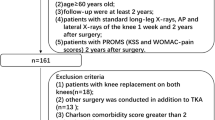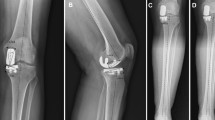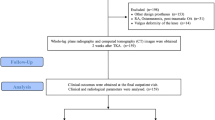Abstract
Purpose
To investigate the appropriate mediolateral placement of symmetrical tibial components and the amount of overhang expected from the posterolateral of tibial components implanted to give ideal coverage and the subsequent incidence of residual knee pain and reduction in functional capacity.
Method
A retrospective evaluation was made of 146 consecutive total knee arthroplasties. The posterolateral overhang, rotational alignment and coverage of the tibial component were measured on a post-operative CT scan and the effect of posterolateral overhang on clinical outcomes was analysed 3 years after surgery.
Results
Complaints of local pain in the posterolateral corner were determined in 76 (52.1%) patients. At the Posterolateral corner, overhang was determined in 111 (76%) patients, in the cortical border in 11 (7.6%) patients and underhang in 24 (16.4%) patients. In 71 (48.6%) patients, pain was determined together with oversize and in the evaluation of the overhang of the tibial component in the posterolateral region and the rotation status, there was determined to be overhang in 75 (96.2%) patients where the tibial component was placed in ideal rotation, in 25 (100%) where placement was in external rotation and in 11 (25.6%) where placement was in internal rotation. The mean KSS, KSS-F and WOMAC-P scores were 83.9 ± 6.3, 83.3 ± 7.8 and 4.6 ± 2.9, respectively, in those with posterolateral overhang of the tibial component .The mean KSS, KSS-F and WOMAC-P scores were 86.6 ± 8.4, 89.5 ± 7.8 and 2.8 ± 2.1, respectively, in those with no overhang and the difference was determined to be statistically significant. The amount of overhang was determined as mean 3.6 ± 2.0 mm in those with posterolateral pain and 0.02 ± 3.4 mm in those without pain and the difference was statistically significant.
Conclusions
This study demonstrated that overhang in the posterolateral region is surprisingly high and negatively affects the clinical results following TKA, thereby presenting a danger to the success of TKA. The risk of posterolateral oversizing can increase with placement of the tibial component in external rotation.


Similar content being viewed by others
References
Diduch DR et al (1997) Total knee replacement in young, active patients. Long-term follow-up and functional outcome. J B Jt Surg Am 79(4):575–82
Akagi M et al (1999) Effect of rotational alignment on patellar tracking in total knee arthroplasty. Clin Orthop Relat Res 366:155–63
Anderson JG et al (1996) Functional outcome and patient satisfaction in total knee patients over the age of 75. J Arthroplast 11(7):831–40
Bonnin M et al (2000) Revision in non-infected total knee arthroplasty: an analysis of 69 consecutive cases. Rev Chir Orthop Repar Appar Mot 86(7):694–706
Dennis DA (2004) Evaluation of painful total knee arthroplasty. J Arthroplast 19(4 Suppl 1):35–40
Elson DW, Brenkel IJ (2006) Predicting pain after total knee arthroplasty. J Arthroplast 21(7):1047–1053
Bourne RB et al (2010) Patient satisfaction after total knee arthroplasty: who is satisfied and who is not? Clin Orthop Relat Res 468(1):57–63
Matziolis G et al (2012) Increased flexion position of the femoral component reduces the flexion gap in total knee arthroplasty. Knee Surg Sports Traumatol Arthrosc 20(6):1092–1096
Insall JN, Dorr LD, Scott RD, Scott WN (1989) Rationale of the Knee Society clinical rating system. Clin Orthop Relat Res 248:13–14
Bilbao A et al (2011) Validation of a proposed WOMAC short form for patients with hip osteoarthritis. Health Qual Life Outcome 9(1):75
Berger RA et al (1993) Determining the rotational alignment of the femoral component in total knee arthroplasty using the epicondylar axis. Clin Orthop Relat Res 286:40–7
Berger RA et al (1998) Malrotation causing patellofemoral complications after total knee arthroplasty. Clin Orthop Relat Res 356:144–53.
Lemaire P et al (1997) Tibial component positioning in total knee arthroplasty: bone coverage and extensor apparatus alignment. Knee Surg Sports Traumatol Arthrosc 5(4):251–257
Bonnin MP et al (2011) Is the anterior tibial tuberosity a reliable rotational landmark for the tibial component in total knee arthroplasty? J Arthroplast 26(2):260–267 (e1–2)
Yang B et al (2012) Sex, age, and annual incidence of primary total knee arthroplasty: a university affiliated hospital survey of 3118 Chinese patients. Chin Med J (Engl) 125(22):3952–3955
Booth RE Jr (2006) Sex and the total knee: gender-sensitive designs. Orthopedics 29(9):836–838
Baldini A et al (2013) Rotational alignment of the tibial component in total knee arthroplasty: the anterior tibial cortex is a reliable landmark. Joints 1(4):155–60
Incavo SJ et al (1994) Tibial plateau coverage in total knee arthroplasty. Clin Orthop Relat Res 299:81–5
Kwak DS et al (2007) Morphometry of the proximal tibia to design the tibial component of total knee arthroplasty for the Korean population. Knee 14(4):295–300
Bonnin MP et al (2013) Mediolateral oversizing influences pain, function, and flexion after TKA. Knee Surg Sports Traumatol Arthrosc 21(10):2314–2324
Chau R et al (2009) Tibial component overhang following unicompartmental knee replacement—does it matter? Knee 16(5):310–313
Martin S, Saurez A, Ismaily S, Ashfaq K, Noble P, Incavo SJ (2014) Maximizing tibial coverage is detrimental to proper rotational alignment. Clin Orthop Relat Res 472(1):121–125
Peersman G et al (2016) Malrotation deformities of the lower extremity and implications on total knee arthroplasty: a narrative review. Arch Orthop Trauma Surg 136(11):1491–1498
Thienpont E et al (2017) Bone morphotypes of the varus and valgus knee. Arch Orthop Trauma Surg 137(3):393–400
Foruria X, Schmidt-Braekling T et al (2017) Does the tibia component design affect the need for offset stems in revision total knee arthroplasty? Arch Orthop Trauma Surg 137(6):853–860
Hitt K et al (2003) Anthropometric measurements of the human knee: correlation to the sizing of current knee arthroplasty systems. J B Jt Surg Am 85-A(Suppl4):115–22
Dai Y, Bischoff JE (2013) Comprehensive assessment of tibial plateau morphology in total knee arthroplasty: influence of shape and size on anthropometric variability. J Orthop Res 31(10):1643–1652
Mahoney OM, Kinsey T (2010) Overhang of the femoral component in total knee arthroplasty: risk factors and clinical consequences. J B Jt Surg Am 92(5):1115–1121
Heyse TJ, Tibesku CO (2015) Improved tibial component rotation in TKA using patient-specific instrumentation. Arch Orthop Trauma Surg 135(5):697–701
Bonnin MP et al (2017) Popliteus impingement after TKA may occur with well-sized prostheses. Knee Surg Sports Traumatol Arthrosc 25(6):1720–1730
Barnes CL, Scott RD (1995) Popliteus tendon dysfunction following total knee arthroplasty. J Arthroplast 10(4):543–545
Kazakin A, Nandi S, Bono J (2014) Diagnosis and treatment of intraoperative popliteus tendon impingement. J Knee Surg 27(6):485–488
Luyckx L et al (2010) Iliotibial band traction syndrome in guided motion TKA. A new clinical entity after TKA. Acta Orthop Belg 76(4):507–12
Hirakawa MKM, Tomari K, Higuma Y, Ikeda S, Noguchi T, Tsumura H (2013) Posterolateral overhang of the femoral component in total knee arthroplasty. B Jt J 95-B(SUPP 15):197
Harwin SF, Greene KA, Hitt K (2007) Early experience with a new total knee implant: maximizing range of motion and function with gender-specific sizing. Surg Technol Int 16:199–205
Shah DS, Ghyar R, Ravi B, Shetty V (2013) 3D morphological study of the Indian arthritic knee: comparison with other ethnic groups and conformity of current TKA implant. Open J Rheumatol Autoimmun Dis 3:263–269
Author information
Authors and Affiliations
Corresponding author
Ethics declarations
Conflict of interest
The authors declare that they have no conflict of interest.
Funding
There is no funding source.
Ethical approval
This article does not contain any studies with human participants or animals performed by any of the authors.
Informed consent
Informed consent was obtained from all individual participants included in the study.
Rights and permissions
About this article
Cite this article
Simsek, M.E., Akkaya, M., Gursoy, S. et al. Posterolateral overhang affects patient quality of life after total knee arthroplasty. Arch Orthop Trauma Surg 138, 409–418 (2018). https://doi.org/10.1007/s00402-017-2850-4
Received:
Published:
Issue Date:
DOI: https://doi.org/10.1007/s00402-017-2850-4




